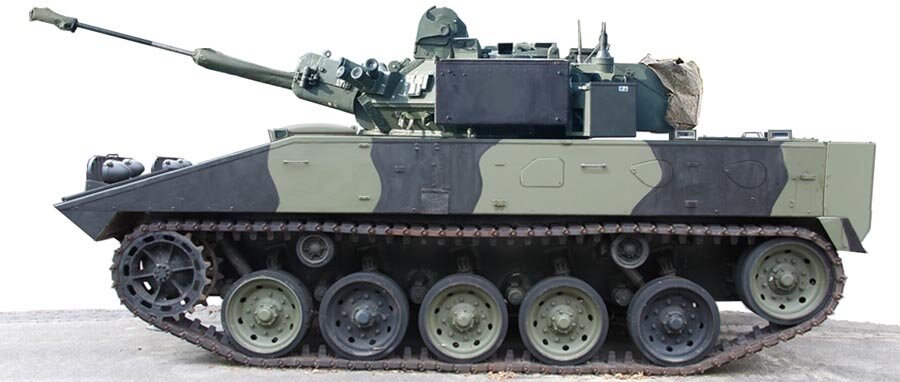This is BAOR's artillery order of battle in March 1956 according to Pages 31 to 37 of
"The British Army in Germany (BAOR and after): An Organizational History" by Graham E. Watson and Richard A. Rinaldi.
Directly under HQ I British Corps
24th Medium Regiment RA (2, 51 & 128 Batteries) with towed 5.5in howitzers.
58th Medium Regiment RA (118 & 175 Batteries) with towed 5.5in howitzers.
94th Locating Regiment RA (112 Battery)
5th Army Group Royal Artillery (Anti-Aircraft)
30th HAA Regiment RA (76, 77 & 85 Batteries) with 3.7in HAA guns.
44th HAA Regiment RA (46, 153 & 154 Batteries) with 3.7in HAA guns.
77th HAA Regiment RA (29, 37, 41 & 221 Batteries) with 3.7in HAA guns.
35th LAA Regiment RA (90, 92 & 99 Batteries) with Bofors 40mm LAA guns.
72nd LAA Regiment RA (6, 42, 44 & 91 Batteries) with Bofors 40mm LAA guns.
74th LAA Regiment RA (200, 202, 230 & 231 Batteries) with Bofors 40mm LAA guns.
2nd Infantry Division (4th Guards, 5th Infantry and 6th Infantry Brigades)
29th Field Regiment RA (8, 79 & 145 Batteries) with towed 25pd gun/howitzers.
41st Field Regiment RA (85, 105 & 165 Batteries) with towed 25pd gun/howitzers.
45th Field Regiment RA (70, 116 & 176 Batteries) with towed 25pd gun/howitzers.
22nd LAA Regiment RA (47, 48 & 53 Batteries) with Bofors 40mm LAA guns.
115th Locating Battery RA
'Z' Light Mortar Battery RA
6th Armoured Division (20th Armoured and 61st Lorried Infantry Brigades)
1st Field Regiment RHA (A, B & E Batteries) with Sexton self-propelled 25pdr gun/howitzers.
5th Field Regiment RHA (C, G & K Batteries) with Sexton self-propelled 25pdr gun/howitzers.
16th LAA Regiment RA (26, 30 & 32 Batteries) with Bofors 40mm LAA guns.
156th Locating Battery RA
7th Armoured Division (7th Armoured and 31st Lorried Infantry Brigades)
4th Field Regiment RHA (F, N & P Batteries) with Sexton self-propelled 25pdr gun/howitzers.
6th Field Regiment RA (H, V & W Batteries) with Sexton self-propelled 25pdr gun/howitzers.
12th LAA Regiment RA (T, 9 & 34 Batteries) with Bofors 40mm LAA guns.
204th Locating Battery RA
11 Armoured Division (33rd Armoured and 91st Lorried Infantry Brigades)
2nd Field Regiment RHA (I, L & O Batteries) with Sexton self-propelled 25pdr gun/howitzers.
10th Field Regiment RA (Q, X & Y Batteries) with Sexton self-propelled 25pdr gun/howitzers.
53rd LAA Regiment RA (56, 106 & 110 Batteries) with Bofors 40mm LAA guns.
157th Locating Battery RA
That's a total of 71 batteries distributed amongst 22 Regimental Headquarters (RHQs).
- 33 batteries of tube AA artillery distributed amongst 10 RHQs.
- 10 HAA batteries distributed amongst 3 RHQs.
- The book didn't say what their equipment was, buy my guess is that they had 3.7in guns.
- 23 LAA batteries with Bofors 40mm guns distributed amongst 7 RHQs.
- 33 batteries of tube medium and field artillery distributed amongst 11 RHQs.
- 5 medium batteries of towed 5.5in howitzers distributed amongst 2 RHQs.
- 18 batteries of Sexton self-propelled 25pdr gun/howitzers distributed amongst 6 RHQs.
- 9 batteries of towed 25pdr gun/howitzers distributed amongst 3 RHQs.
- One independent battery of mortars.
- 5 locating batteries and one RHQ.
Unfortunately, I don't know the number of guns per battery and therefore I can't calculate the total number of guns.

